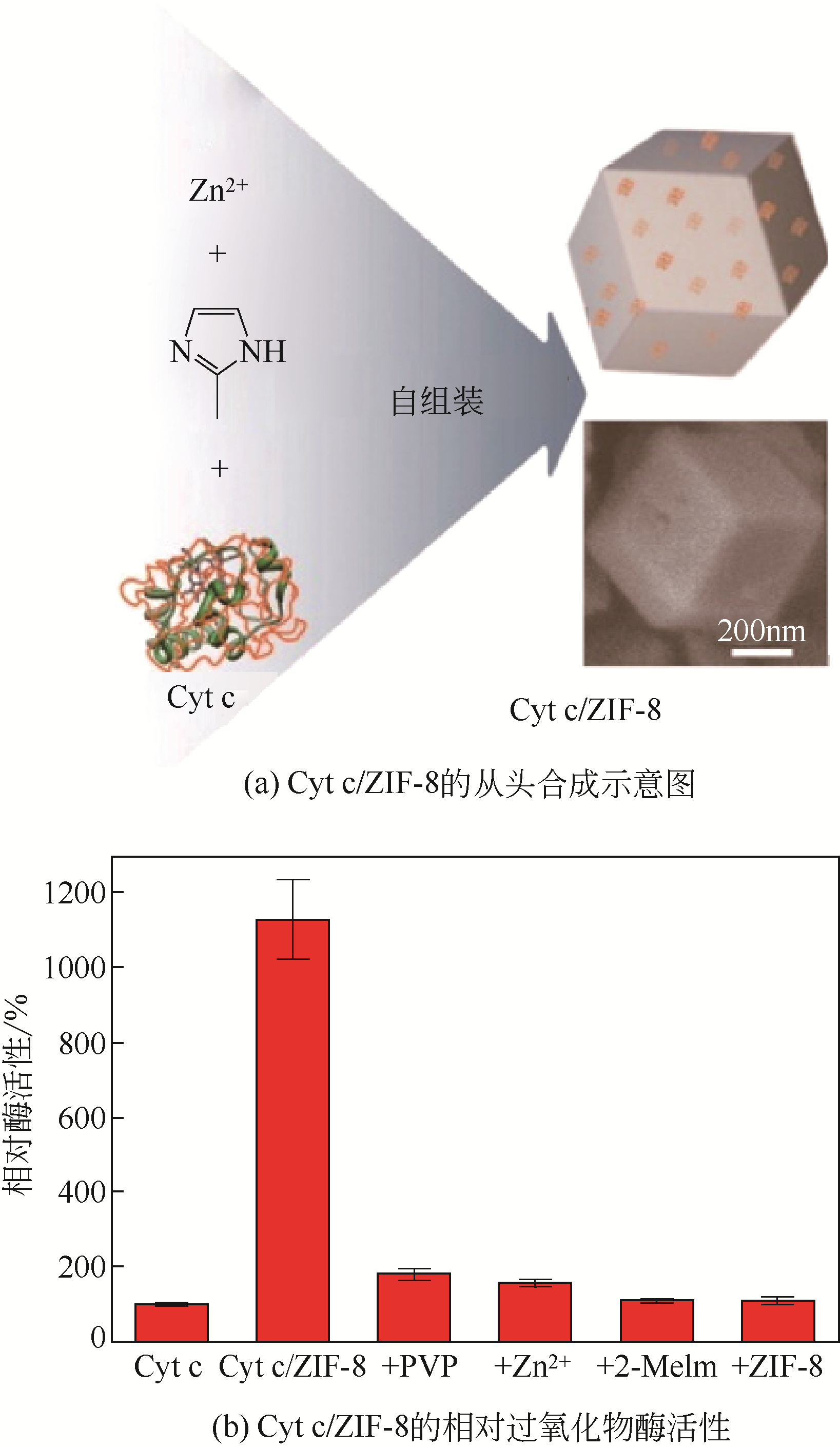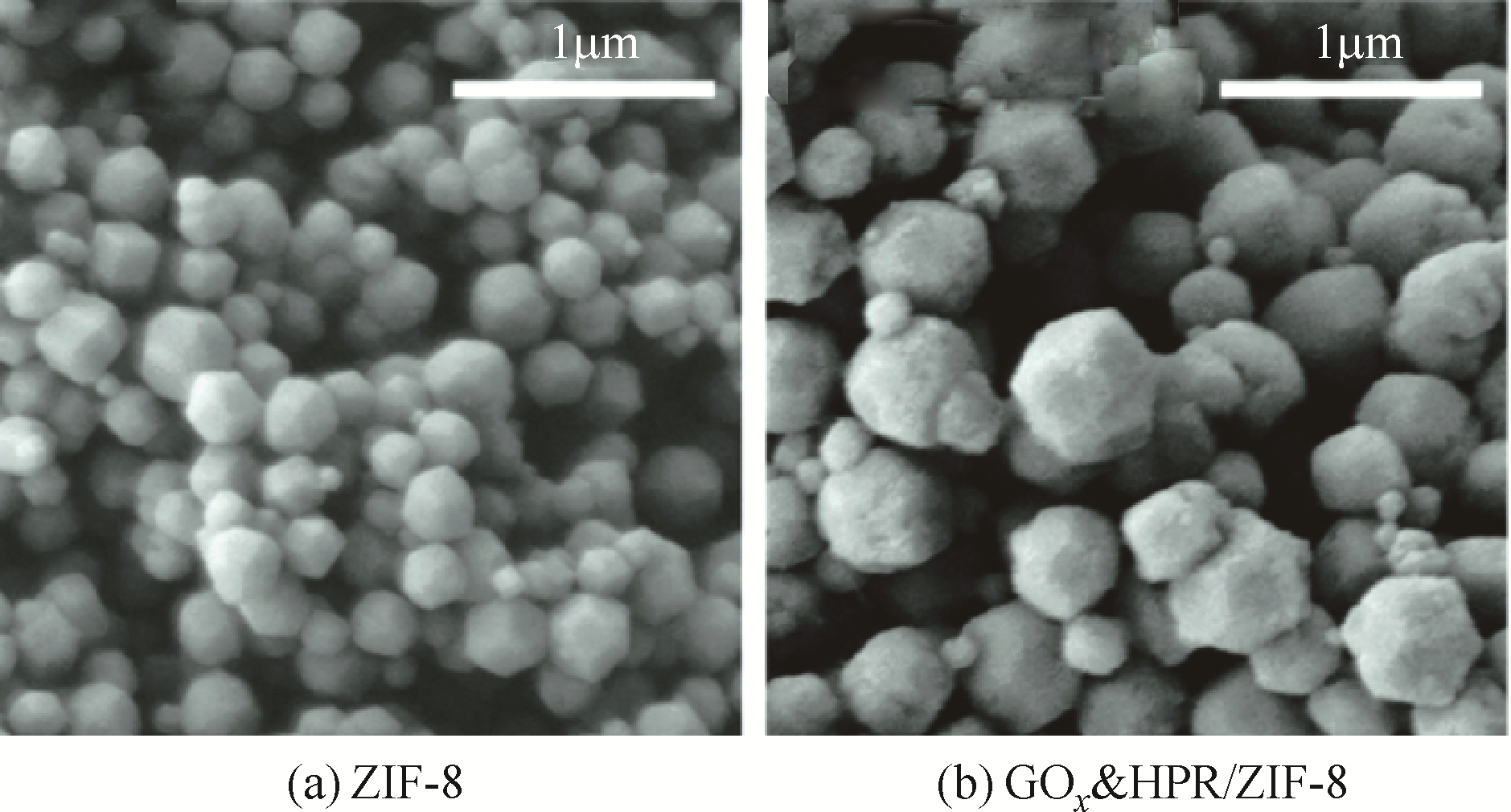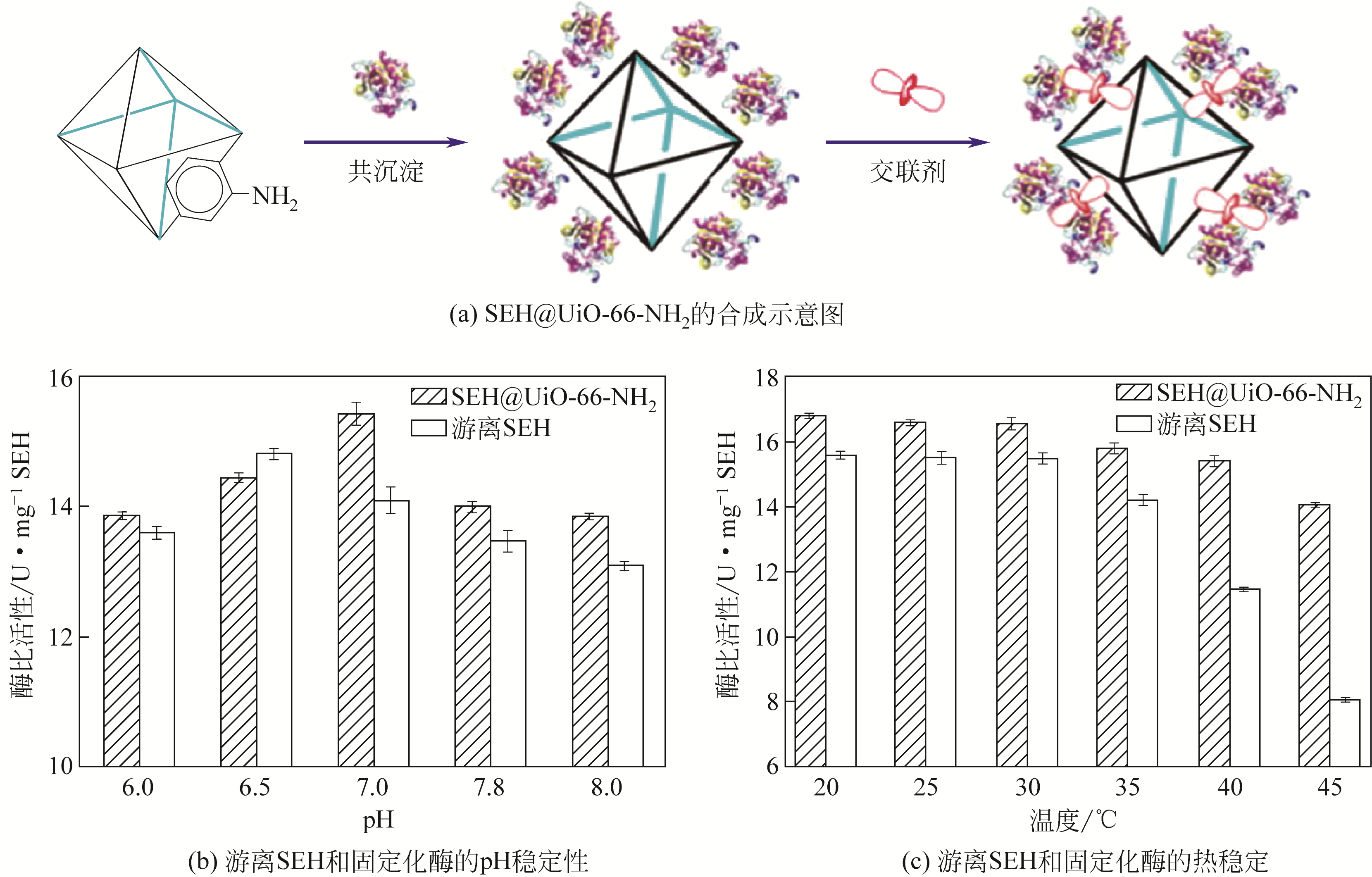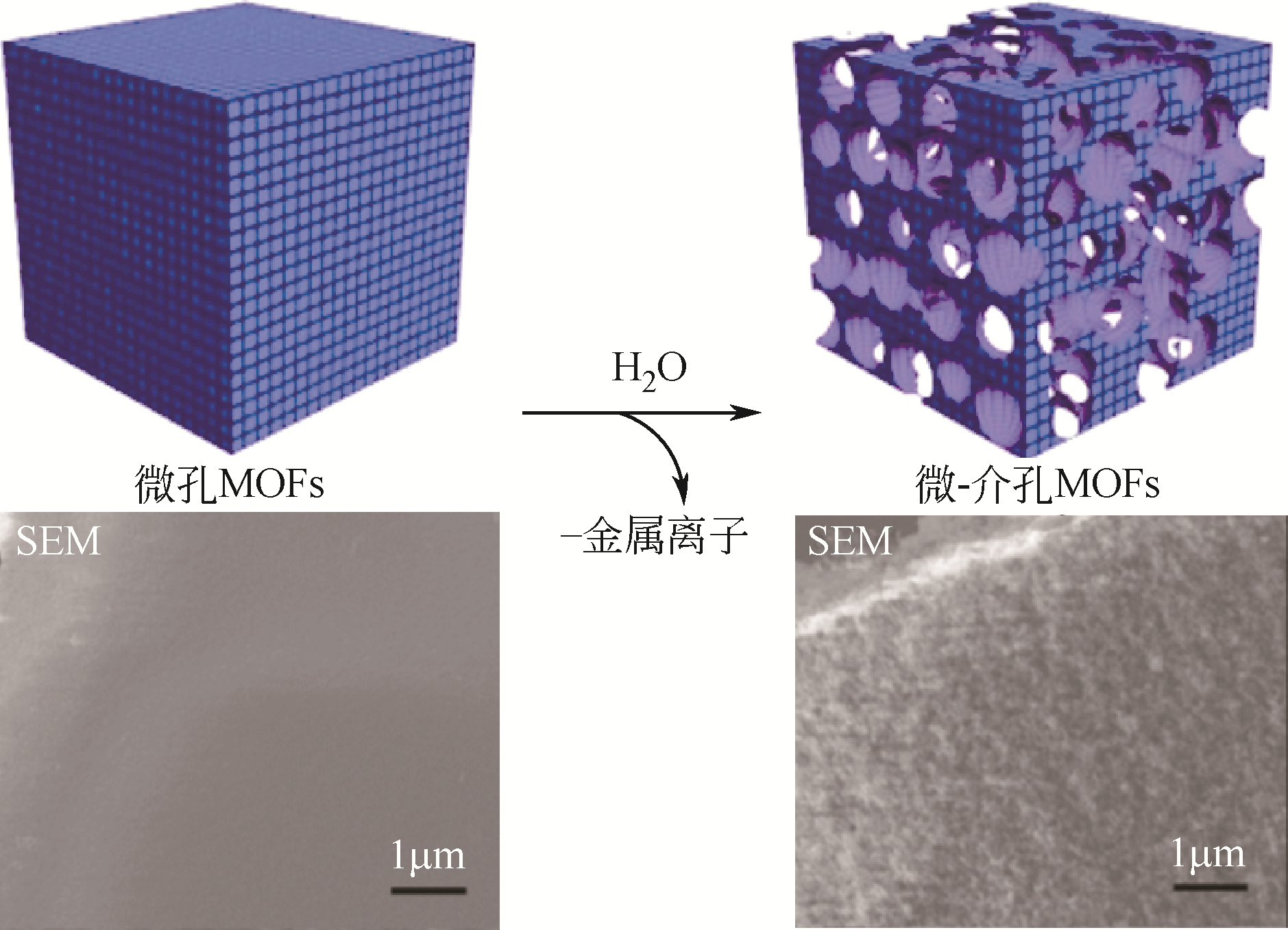化工进展 ›› 2019, Vol. 38 ›› Issue (06): 2889-2897.DOI: 10.16085/j.issn.1000-6613.2018-1883
金属有机框架固定化酶及其在环境中的应用
- 上海交通大学环境科学与工程学院,上海 200240
-
收稿日期:2018-09-19出版日期:2019-06-05发布日期:2019-06-05 -
通讯作者:迟莉娜 -
作者简介:解婷婷(1990—),女,硕士研究生,研究方向为酶的固定化和酶膜的制备。E-mail:<email>qq1006420052@sjtu.edu.cn</email>。 -
基金资助:国家水体污染控制与治理科技重大专项(2017ZX07203-005);国家自然科学基金(21737002)
Immobilization of enzymes on metal-organic frameworks and its application in environmental fields
Tingting XIE( ),Lina CHI(
),Lina CHI( ),Ruiting LIU,Xinze WANG
),Ruiting LIU,Xinze WANG
- School of Environmental Science and Engineering, Shanghai Jiao Tong University, Shanghai 200240, China
-
Received:2018-09-19Online:2019-06-05Published:2019-06-05 -
Contact:Lina CHI
摘要:
固定化酶克服了游离酶易失活、稳定性差、难以回收利用的缺点,扩大了酶的实际应用范围。近年来,由于金属有机框架(metal-organic frameworks,MOFs)独特的性质,如比表面积大、孔隙率高、孔径可调节、开放的金属位点和多样的结构组成等,其作为固定化酶的新型载体成为研究热点。本文综述了近年来MOFs固定化酶的研究进展,其中重点讨论了酶在MOFs上的固定化方法(从头合成和后合成)和机理(载体包埋、表面吸附、共价连接和孔道扩散),并且分析了不同合成方法的优势和局限性,如从头合成可以选择孔径小于目标酶尺寸的MOFs,但要求MOFs的合成条件温和;后合成可以选择合成条件苛刻的MOFs,但固定化过程相对复杂。此外,还对MOFs固定化酶在环境污染物检测和去除方面的应用进展进行了总结。最后对MOFs固定化酶在环境领域的应用研究和面临的挑战进行了展望,提出应关注MOFs固定化酶中MOFs和酶对污染物的协同作用以及MOFs固定化酶的可控制备。
中图分类号:
引用本文
解婷婷, 迟莉娜, 刘瑞婷, 王欣泽. 金属有机框架固定化酶及其在环境中的应用[J]. 化工进展, 2019, 38(06): 2889-2897.
Tingting XIE, Lina CHI, Ruiting LIU, Xinze WANG. Immobilization of enzymes on metal-organic frameworks and its application in environmental fields[J]. Chemical Industry and Engineering Progress, 2019, 38(06): 2889-2897.
| 合成方法 | 酶 | 酶的尺寸/? | MOFs | MOFs孔径/? | 固载机理 | 参考文献 |
|---|---|---|---|---|---|---|
| 从头合成 | CAT | 约100 | ZIF-90 | 11.2 | 载体包埋 | [ |
| Cyt c | 约26×32×33 | ZIF-8 | 11.6 | 载体包埋 | [ | |
| GOx&HPR | — | ZIF-8 | 11.6 | 载体包埋 | [ | |
| CPO | — | ZIF-8 | 11.6 | 载体包埋 | [ | |
| BHb | — | ZIF-8 | 11.6 | 载体包埋 | [ | |
| 后合成 | HPR | 约40×44×68 | IPD-mesoMOF-3 | 150~500 | 表面吸附 | [ |
| Lac-T | 约65×55×45 | Zr-MOF | 35~70 | 表面吸附 | [ | |
| GDH | — | ZIF-70 | — | 表面吸附 | [ | |
| MP-11 | 约33×17×11 | [Cu(BPDC) (DABCO)] n | 22×9 | 表面吸附 | [ | |
| Try | — | MILL-88B-NH2(Cr) | — | 共价键连接 | [ | |
| CAL-B | — | IRMOF-3 | 11.2, 14.5 | 共价键连接 | [ | |
| SEH | — | UiO-66-NH2 | 8.5 | 共价键连接 | [ | |
| OPAA | 约78×44×44 | PCN-128y | 44 | 孔道扩散 | [ | |
| MP-11 | 约33×17×11 | Tb-mesoMOF | 9, 30, 41 | 孔道扩散 | [ | |
| Cyt c | 约26×32×33 | POST-66(Y) | 30~200 | 孔道扩散 | [ | |
| HPR | 约40×44×68 | POST-66(Y) | 30~200 | 孔道扩散 | [ |
表1 MOFs固定化酶的组合、合成方法及机理
| 合成方法 | 酶 | 酶的尺寸/? | MOFs | MOFs孔径/? | 固载机理 | 参考文献 |
|---|---|---|---|---|---|---|
| 从头合成 | CAT | 约100 | ZIF-90 | 11.2 | 载体包埋 | [ |
| Cyt c | 约26×32×33 | ZIF-8 | 11.6 | 载体包埋 | [ | |
| GOx&HPR | — | ZIF-8 | 11.6 | 载体包埋 | [ | |
| CPO | — | ZIF-8 | 11.6 | 载体包埋 | [ | |
| BHb | — | ZIF-8 | 11.6 | 载体包埋 | [ | |
| 后合成 | HPR | 约40×44×68 | IPD-mesoMOF-3 | 150~500 | 表面吸附 | [ |
| Lac-T | 约65×55×45 | Zr-MOF | 35~70 | 表面吸附 | [ | |
| GDH | — | ZIF-70 | — | 表面吸附 | [ | |
| MP-11 | 约33×17×11 | [Cu(BPDC) (DABCO)] n | 22×9 | 表面吸附 | [ | |
| Try | — | MILL-88B-NH2(Cr) | — | 共价键连接 | [ | |
| CAL-B | — | IRMOF-3 | 11.2, 14.5 | 共价键连接 | [ | |
| SEH | — | UiO-66-NH2 | 8.5 | 共价键连接 | [ | |
| OPAA | 约78×44×44 | PCN-128y | 44 | 孔道扩散 | [ | |
| MP-11 | 约33×17×11 | Tb-mesoMOF | 9, 30, 41 | 孔道扩散 | [ | |
| Cyt c | 约26×32×33 | POST-66(Y) | 30~200 | 孔道扩散 | [ | |
| HPR | 约40×44×68 | POST-66(Y) | 30~200 | 孔道扩散 | [ |
| 1 | KAUSHAL J , MEHANDIA S , SINGH G , et al . Catalase enzyme: application in bioremediation and food industry[J]. Biocatalysis and Agricultural Biotechnology, 2018, 16: 192-199. |
| 2 | PELLIS A , SILVESTRINI L , SCAINI D , et al . Enzyme-catalyzed functionalization of poly (L-lactic acid) for drug delivery applications[J]. Process Biochemistry, 2017, 59: 77-83. |
| 3 | 杨杰, 张玉彬, 吴梧桐 . 固定化酶技术及其在医药上的应用新进展[J]. 药物生物技术, 2013, 20(6): 553-556. |
| YANG J , ZHANG Y B , WU W T . Technique of immobilized enzyme and its application in medicine[J]. Pharmaceutical Biotechnology, 2013, 20(6): 553-556. | |
| 4 | NELSON J M , GRIFFIN E G . Adsorption of invertase[J]. Journal of the American Chemical Society, 1916, 38(5): 1109-1115. |
| 5 | 丁齐, 邢晓东, 李丽霞 . 多孔半互穿温敏水凝胶点击反应固定化酶[J]. 化工进展, 2014, 33(4): 971-976. |
| DING Q , XING X D , LI L X . Enzyme immobilization on porous semi-interpenetrating thermosensitive hydrogel carriers via thiol-based click reaction[J]. Chemical Industry and Engineering Progress, 2014, 33(4): 971-976. | |
| 6 | PANDEY V P , RANI J , JAISWAL N , et al . Chitosan immobilized novel peroxidase from Azadirachta indica: characterization and application[J]. International Journal of Biological Macromolecules, 2017, 104: 1713-1720. |
| 7 | BERNINI F , CASTELLINI E , BERTO M , et al . Solvent tunes the peroxidase activity of cytochrome c immobilized on kaolinite[J]. Applied Clay Science, 2015, 118: 316-324. |
| 8 | 张笛, 邓满凤, 赵赫, 等 . 多巴胺包埋磁性SiO2固定化漆酶催化去除4-氯酚[J]. 化工学报, 2015, 66(9): 3705-3711. |
| ZHANG D , DENG M F , ZHAO H , et al . Immobilization of laccase on magnetic SiO2 through dopamine self-polymerization for 4-CP removal[J].CIESC J., 2015, 66(9): 3705-3711. | |
| 9 | ZHOU L , WANG C , JIANG Y , et al . Immobilization of papain in biosilica matrix and its catalytic property[J]. Chinese Journal of Chemical Engineering, 2013, 21(6): 670-675. |
| 10 | 张义芹, 王正, 唐爱星, 等 . 功能化碳纳米管固定化脂肪酶的制备及其合成生物柴油研究[J]. 可再生能源, 2016, 34(9): 1411-1416. |
| ZHANG Y Q , WANG Z , TANG A X , et al . Immobilization of lipase on functionalized multi-walled carbon nanotubes for biodiesel preparation[J]. Renewable Energy Resources, 2016, 34(9): 1411-1416. | |
| 11 | MOHAMED S A , AL-HARBI M H , ALMULAIKY Y Q , et al . Immobilization of horseradish peroxidase on Fe3O4 magnetic nanoparticles[J]. Electronic Journal of Biotechnology, 2017, 27: 84-90. |
| 12 | LONG J , ZHANG B , LI X , et al . Effective production of resistant starch using pullulanase immobilized onto magnetic chitosan/Fe3O4 nanoparticles[J]. Food Chemistry, 2018, 239: 276-286. |
| 13 | ZHANG W , QIU J , FENG H , et al . Increase in stability of cellulase immobilized on functionalized magnetic nanospheres[J]. Journal of Magnetism & Magnetic Materials, 2015, 375: 117-123. |
| 14 | HUDSON S , COONEY J , MAGNER E . Proteins in mesoporous silicates[J]. Angewandte Chemie, 2010, 47(45): 8582-8594. |
| 15 | LI P , MOON S Y , GUELTA M A , et al . Encapsulation of a nerve agent detoxifying enzyme by a mesoporous zirconium metal-organic framework engenders thermal and long-term stability[J]. Journal of the American Chemical Society, 2016, 138(26): 8052-8055. |
| 16 | SHIH Y H , LO S H, YANG N S , et al . Trypsin-immobilized metal-organic framework as a biocatalyst in proteomics analysis[J]. ChemPlusChem, 2012, 77(11): 982-986. |
| 17 | MA W, JIANG Q , YU P , et al . Zeolitic imidazolate framework-based electrochemical biosensor for in vivo electrochemical measurements[J]. Analytical Chemistry, 2013, 85(15): 7550-7557. |
| 18 | 田运齐, 吴小芳, 侯文颖, 等 . 辣根过氧化物酶在MOF上的固定化研究[J]. 辽宁师范大学学报(自然科学版), 2016, 39(3): 373-376. |
| TIAN Y Q , WU X F , HOU W Y , et al . Immobilization of horseradish peroxidase on the metal-organic framework[J]. Journal of Liaoning Normal University, 2016, 39(3): 373-376. | |
| 19 | KIM Y, YANG T , YUN G , et al . Hydrolytic transformation of microporous metal-organic frameworks to hierarchical micro- and mesoporous MOFs[J]. Angewandte Chemie, 2015, 127(45): 13273-13278. |
| 20 | JIANG D , XU P , WANG H , et al . Strategies to improve metal organic frameworks photocatalyst’s performance for degradation of organic pollutants[J]. Coordination Chemistry Reviews, 2018, 376: 449-466 |
| 21 | KADHOM M , DENG B . Metal-organic frameworks (MOFs) in water filtration membranes for desalination and other applications[J]. Applied Materials Today, 2018, 11: 219-230. |
| 22 | CUI L , WU J , LI J , et al . Electrochemical sensor for lead cation sensitized with a DNA functionalized porphyrinic metal-organic framework[J]. Analytical Chemistry, 2015, 87(20): 10635-10641. |
| 23 | XU H , AGUILAR Z P , YANG L , et al . Antibody conjugated magnetic iron oxide nanoparticles for cancer cell separation in fresh whole blood[J]. Biomaterials, 2011, 32(36): 9758-9765. |
| 24 | LIÉDANA N , GALVE A , RUBIO C , et al . CAF@ZIF-8: one-step encapsulation of caffeine in MOF[J]. ACS Applied Materials & Interfaces, 2012, 4(9): 5016-5021. |
| 25 | LU W . Tuning the structure and function of metal-organic frameworks via linker design[J]. Chemical Society Reviews, 2014, 43(16): 5561-5593. |
| 26 | HINTZ H , WUTTKE S . Postsynthetic modification of an amino-tagged MOF using peptide coupling reagents: a comparative study[J]. Chemical Communications, 2014, 50(78): 11472-11475. |
| 27 | GKANIATSOU E , SICARD C , RICOUX R , et al . Metal-organic frameworks: a novel host platform for enzymatic catalysis and detection[J]. Materials Horizons, 2017, 4(1): 55-63. |
| 28 | CAO L , LANGEN L V , SHELDON R A . Immobilized enzymes: carrier-bound or carrier-free?[J]. Current Opinion in Biotechnology, 2003, 1(4): 387-394. |
| 29 | SHIEH F K , WANG S C , YEN C I, et al . Imparting functionality to biocatalysts via embedding enzymes into nanoporous materials by a de novo approach: size-selective sheltering of catalase in metal-organic framework microcrystals[J]. Journal of the American Chemical Society, 2015, 137(13): 4276-4279. |
| 30 | LÜ F , ZHANG Y , ZARE R N , et al . One-pot synthesis of protein-embedded metal-organic frameworks with enhanced biological activities[J]. Nano Letters, 2014, 14(10): 5761-5765. |
| 31 | WU X , GE J , YANG C , et al . Facile synthesis of multiple enzyme-containing metal-organic frameworks in a biomolecule-friendly environment[J]. Chemical Communications, 2015, 51(69): 13408-13411. |
| 32 | 赵睿南, 胡满成, 李淑妮, 等 . 基于金属有机骨架的固定化氯过氧化物酶的制备和性能评价[J]. 化学学报, 2017, 75(3): 293-299. |
| ZHAO R N , HU M C , LI S N , et al . Immobilization of chloroperoxidase in metal organic framework and its catalytic performance[J]. Acta Chimica Sinica, 2017, 75(3): 293-299. | |
| 33 | YIN Y , CHEN L G , QI X , et al . Protein-metal organic framework hybrid composites with intrinsic peroxidase-like activity as a colorimetric biosensing platform[J]. ACS Appl. Mater. Interfaces, 2016, 8(42): 29052-29061. |
| 34 | PANG S , WU Y , ZHANG X , et al . Immobilization of laccase via adsorption onto bimodal mesoporous Zr-MOF[J]. Process Biochemistry, 2016, 51(2): 229-239. |
| 35 | PISKLAK T J , MACÍAS M , COUTINHO D H , et al . Hybrid materials for immobilization of MP-11 catalyst[J]. Topics in Catalysis, 2006, 38(4): 269-278. |
| 36 | JUNG S , KIM Y, KIM S J, et al . Bio-functionalization of metal-organic frameworks by covalent protein conjugation[J]. Chemical Communications, 2011, 47(10): 2904-2906. |
| 37 | CAO S L , YUE D M , LI X H , et al . Novel nano-/micro-biocatalyst: soybean epoxide hydrolase immobilized on UiO-66-NH2 MOF for efficient biosynthesis of enantiopure (R)-1, 2-octanediol in deep eutectic solvents[J]. ACS Sustainable Chemistry & Engineering, 2016, 4(6): 3586-3595. |
| 38 | LYKOURINOU V , CHEN Y , WANG X-S , et al . Immobilization of MP-11 into a mesoporous metal-organic framework, MP-11@mesoMOF: a new platform for enzymatic catalysis[J]. Journal of the American Chemical Society, 2011, 133(27): 10382-10385. |
| 39 | ZHU Q , ZHUANG W , CHEN Y , et al . Nano-biocatalysts of Cyt c@ZIF-8/GO composites with high recyclability via a de novo approach[J]. ACS Appl. Mater. Interfaces, 2018, 10(18): 16066-16076. |
| 40 | HERNANDEZ K , FERNANDEZ-LAFUENTE R . Control of protein immobilization: coupling immobilization and site-directed mutagenesis to improve biocatalyst or biosensor performance[J]. Enzyme & Microbial Technology, 2011, 48(2): 107-122. |
| 41 | CHEN Y , LYKOURINOU V , HOANG T , et al . Size-selective biocatalysis of myoglobin immobilized into a mesoporous metal-organic framework with hierarchical pore sizes[J]. Inorganic Chemistry, 2012, 51(17): 9156-9158. |
| 42 | WANG Q , LIAN X , FANG Y , et al . Applications of immobilized bio-catalyst in metal-organic frameworks[J]. Catalysts, 2018, 8(4): 166-176. |
| 43 | 刘秀红, 常雁红, 罗晖 . 环境领域中固定化酶的应用[J]. 安徽农业科学, 2014, 42(21): 7171-7174. |
| LIU X H , CHANG Y H , LUO H . Applications of the immobilized enzyme in environmental fields[J]. Journal of Anhui Agricultural Sciences, 2014, 42(21): 7171-7174. | |
| 44 | WANG X , LU X , WU L , et al . 3D metal-organic framework as highly efficient biosensing platform for ultrasensitive and rapid detection of bisphenol A[J]. Biosensors and Bioelectronics, 2015, 65: 295-301. |
| 45 | LU X , WANG X , WU L , et al . Response characteristics of bisphenols on a metal-organic framework-based tyrosinase nanosensor[J]. ACS Applied Materials & Interfaces, 2016, 8(25): 16533-16539. |
| 46 | ZHANG T , WANG L , GAO C , et al . Hemin immobilized into metal-organic frameworks as an electrochemical biosensor for 2,4,6-trichlorophenol[J]. Nanotechnology, 2018, 29(7): 074003. |
| 47 | DONG S , ZHANG D , SUO G , et al . Exploiting multi-function metal-organic framework nanocomposite Ag@Zn-TSA as highly efficient immobilization matrixes for sensitive electrochemical biosensing[J]. Analytica Chimica Acta, 2016, 934: 203-211. |
| 48 | 庞仕龙 . 介孔金属有机骨架复合材料固定化漆酶及应用[D]. 北京:北京林业大学, 2016. |
| PANG S L . Immobilization of laccase onto mesoporous MOFs composite and the application of immobilized laccase[D]. Beijing: Beijing Forestry University, 2016. | |
| 49 | 李小娟, 何长发, 黄斌, 等 . 金属有机骨架材料吸附去除环境污染物的进展[J]. 化工进展, 2016, 35(2): 586-594. |
| LI X J , HE C F , HUANG B , et al . Progress in the applications of metal-organic frameworks in adsorption removal of hazardous materials[J]. Chemical Industry and Engineering Progress, 2016, 35(2): 586-594. |
| [1] | 葛全倩, 徐迈, 梁铣, 王凤武. MOFs材料在光电催化领域应用的研究进展[J]. 化工进展, 2023, 42(9): 4692-4705. |
| [2] | 李由, 吴越, 钟禹, 林琦璇, 任俊莉. 酸性熔盐水合物预处理麦秆高效制备木糖及其对酶解效率的影响[J]. 化工进展, 2023, 42(9): 4974-4983. |
| [3] | 陈娜, 张肖静, 张楠, 马冰冰, 张涵, 杨浩洁, 张宏忠. 淬灭酶对亚硝化-混合自养脱氮系统的影响[J]. 化工进展, 2023, 42(7): 3816-3823. |
| [4] | 鲁少杰, 刘佳, 冀芊竹, 李萍, 韩月阳, 陶敏, 梁文俊. 硅藻土基复合填料制备及滴滤塔去除二甲苯的性能[J]. 化工进展, 2023, 42(7): 3884-3892. |
| [5] | 朱雅静, 徐岩, 简美鹏, 李海燕, 王崇臣. 金属有机框架材料用于海水提铀的研究进展[J]. 化工进展, 2023, 42(6): 3029-3048. |
| [6] | 蒋博龙, 崔艳艳, 史顺杰, 常嘉城, 姜楠, 谭伟强. 过渡金属Co3O4/ZnO-ZIF氧还原催化剂Co/Zn-ZIF模板法制备及其产电性能[J]. 化工进展, 2023, 42(6): 3066-3076. |
| [7] | 张耀丹, 孙若溪, 陈鹏程. 以级联反应为基础的多酶共固定载体研究进展[J]. 化工进展, 2023, 42(6): 3167-3176. |
| [8] | 秦凯, 杨仕林, 李俊, 储震宇, 薄翠梅. 基于卡尔曼滤波算法的葡萄糖酶生物传感器高精度检测方法[J]. 化工进展, 2023, 42(6): 3177-3186. |
| [9] | 孙鲁芹, 卢会霞, 王建友. 电渗析/超滤内在耦合过程分离蛋清中溶菌酶[J]. 化工进展, 2023, 42(5): 2262-2271. |
| [10] | 毛梦雷, 孟令玎, 高蕊, 孟子晖, 刘文芳. 多孔框架材料固定化酶研究进展[J]. 化工进展, 2023, 42(5): 2516-2535. |
| [11] | 吴中杰, 谢连科, 王晶辉, 黄仁亮. 多级结构羟基硝酸铜纳米酶的制备及其对酚类污染物的降解[J]. 化工进展, 2023, 42(1): 497-505. |
| [12] | 高帷韬, 殷屺男, 涂自强, 龚繁, 李阳, 徐宏, 王诚, 毛宗强. 金属有机框架材料中的质子传导及其在质子交换膜中的应用[J]. 化工进展, 2022, 41(S1): 260-268. |
| [13] | 孟令玎, 毛梦雷, 廖奇勇, 孟子晖, 刘文芳. 碳酸酐酶和甲酸脱氢酶的稳定性研究进展[J]. 化工进展, 2022, 41(S1): 436-447. |
| [14] | 蒲福龙, 伍尚炜, 郑映玲, 郑玉意, 侯雪丹. 基于乳酸的深度共熔溶剂提取秸秆木质素对纤维素酶水解效率的影响[J]. 化工进展, 2022, 41(9): 4937-4945. |
| [15] | 方龙龙, 郑文姬, 宁梦佳, 张明扬, 杨雨晴, 代岩, 贺高红. 功能化Zr-MOF强化混合基质膜CO2分离[J]. 化工进展, 2022, 41(9): 4954-4962. |
| 阅读次数 | ||||||
|
全文 |
|
|||||
|
摘要 |
|
|||||





